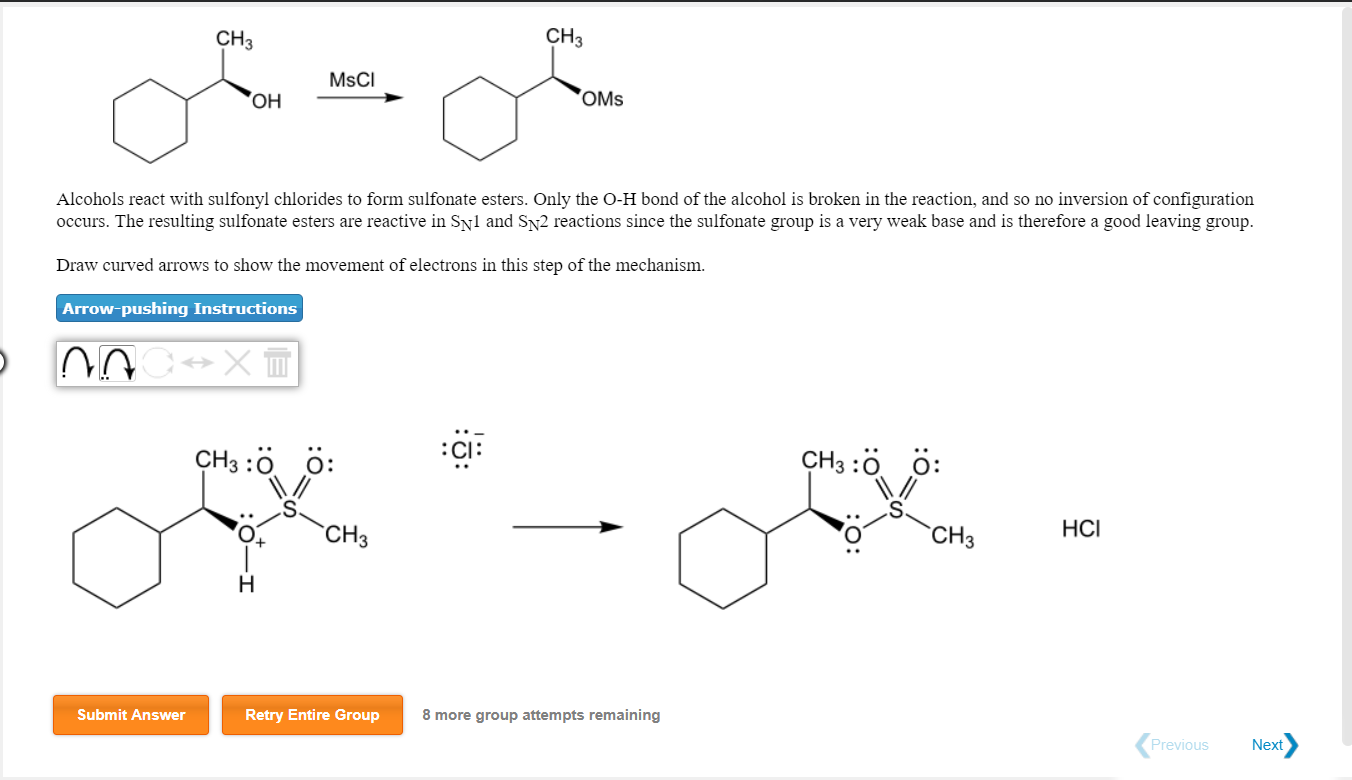CH3 CH3 MsCI OMs Alcohols react with sulfonyl chlorides to form sulfonate esters. Only the O-H bond of the alcohol is broken in the reaction, and so no inversion of configuration occurs. The resulting sulfonate esters are reactive in Svl and SN2 reactions since the sulfonate group is a very weak base and is therefore a good leaving group. Draw curved arrows to show the movement of electrons in this step of the mechanism. Arrow-pushing Instructions :Cl: CH3:O O: CH3:O O: CH3 HCI Submit Answer Retry Entire Group 8 more group attempts remaining Previous Next
CH3 CH3 MsCI OMs Alcohols react with sulfonyl chlorides to form sulfonate esters. Only the O-H bond of the alcohol is broken in the reaction, and so no inversion of configuration occurs. The resulting sulfonate esters are reactive in Svl and SN2 reactions since the sulfonate group is a very weak base and is therefore a good leaving group. Draw curved arrows to show the movement of electrons in this step of the mechanism. Arrow-pushing Instructions :Cl: CH3:O O: CH3:O O: CH3 HCI Submit Answer Retry Entire Group 8 more group attempts remaining Previous Next
Chemistry
10th Edition
ISBN:9781305957404
Author:Steven S. Zumdahl, Susan A. Zumdahl, Donald J. DeCoste
Publisher:Steven S. Zumdahl, Susan A. Zumdahl, Donald J. DeCoste
Chapter1: Chemical Foundations
Section: Chapter Questions
Problem 1RQ: Define and explain the differences between the following terms. a. law and theory b. theory and...
Related questions
Question
100%
Alcohols react with sulfonyl chlorides to form sulfonate esters. Only the O-H bond of the alcohol is broken in the reaction, and so no inversion of configuration occurs. The resulting sulfonate esters are reactive in SN1 and SN2 reactions since the sulfonate group is a very weak base and is therefore a good leaving group.
Draw curved arrows to show the movement of electrons in this step of the mechanism.

Transcribed Image Text:CH3
CH3
MsCI
OMs
Alcohols react with sulfonyl chlorides to form sulfonate esters. Only the O-H bond of the alcohol is broken in the reaction, and so no inversion of configuration
occurs. The resulting sulfonate esters are reactive in Svl and SN2 reactions since the sulfonate group is a very weak base and is therefore a good leaving group.
Draw curved arrows to show the movement of electrons in this step of the mechanism.
Arrow-pushing Instructions
:Cl:
CH3:O O:
CH3:O O:
CH3
HCI
Submit Answer
Retry Entire Group
8 more group attempts remaining
Previous
Next
Expert Solution
This question has been solved!
Explore an expertly crafted, step-by-step solution for a thorough understanding of key concepts.
This is a popular solution!
Trending now
This is a popular solution!
Step by step
Solved in 2 steps with 1 images

Knowledge Booster
Learn more about
Need a deep-dive on the concept behind this application? Look no further. Learn more about this topic, chemistry and related others by exploring similar questions and additional content below.Recommended textbooks for you

Chemistry
Chemistry
ISBN:
9781305957404
Author:
Steven S. Zumdahl, Susan A. Zumdahl, Donald J. DeCoste
Publisher:
Cengage Learning

Chemistry
Chemistry
ISBN:
9781259911156
Author:
Raymond Chang Dr., Jason Overby Professor
Publisher:
McGraw-Hill Education

Principles of Instrumental Analysis
Chemistry
ISBN:
9781305577213
Author:
Douglas A. Skoog, F. James Holler, Stanley R. Crouch
Publisher:
Cengage Learning

Chemistry
Chemistry
ISBN:
9781305957404
Author:
Steven S. Zumdahl, Susan A. Zumdahl, Donald J. DeCoste
Publisher:
Cengage Learning

Chemistry
Chemistry
ISBN:
9781259911156
Author:
Raymond Chang Dr., Jason Overby Professor
Publisher:
McGraw-Hill Education

Principles of Instrumental Analysis
Chemistry
ISBN:
9781305577213
Author:
Douglas A. Skoog, F. James Holler, Stanley R. Crouch
Publisher:
Cengage Learning

Organic Chemistry
Chemistry
ISBN:
9780078021558
Author:
Janice Gorzynski Smith Dr.
Publisher:
McGraw-Hill Education

Chemistry: Principles and Reactions
Chemistry
ISBN:
9781305079373
Author:
William L. Masterton, Cecile N. Hurley
Publisher:
Cengage Learning

Elementary Principles of Chemical Processes, Bind…
Chemistry
ISBN:
9781118431221
Author:
Richard M. Felder, Ronald W. Rousseau, Lisa G. Bullard
Publisher:
WILEY